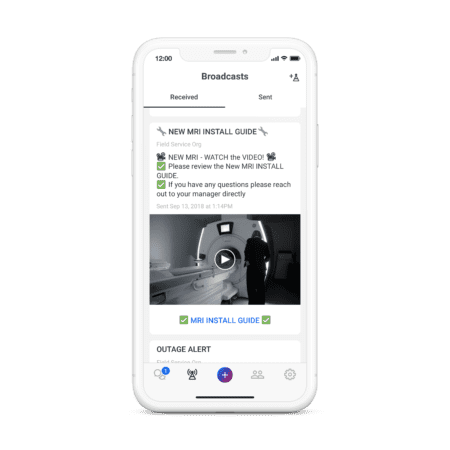3 Employee Retention Techniques for the Deskless Workforce
Deskless workers comprise anywhere from 72-80 percent of the entire workforce. They include field service technicians, hotel staff, utility workers, flight crews, warehouse staff, manufacturing plant engineers — the list goes on. Retention rates in these industries are notoriously low due to the challenging, stressful, and isolating nature of these jobs. Improving employee retention is always top of mind for leaders, but when it comes to the deskless workforce, it has to be done a little differently.
The following three employee retention techniques will help you better connect and support deskless teams so that they’ll want to stick around.
1. Help Them Be Better at Their Jobs
One of the biggest reasons deskless workers leave is because they don’t feel confident in their ability to do their job. Unlike many desk jobs, deskless work means walking into the unknown and leveraging what you know and the resources available to solve a problem in real time, sometimes with a customer standing right next to you or breathing down your neck.
A field service technician, for example, must constantly stay on top of the latest products or upgrades the company offers, knowing both how to install and fix as well as sell them to the customer. All while this is going on, the real work starts when they arrive at a customer’s door and run into a situation they’ve never seen before and must find a way to solve it quickly. It’s a tough job, but with the proper support, deskless workers can feel great about the work they do, rather than get stressed out.

Employee Retention Techniques
Helping deskless workers be better at their jobs is two-fold. Quality, continuous training both online and in-person is one part of the equation. But the other side, often less optimized, is providing great support to deskless teams in real time. When a utility lineman encounters a leaking transformer and isn’t sure which of the two ways he learned to fix it is correct, he needs instant help. For many companies, the process of getting support means calling through a phone tree or sending an email into a long queue of help requests. The amount of time wasted by these inefficient processes is huge, and it affects the metrics on which field-based workers are measured.
Investing in real-time communication technology that replaces archaic methods is quite impactful when it comes to retention. Zinc Real-Time Communication has been deployed at a variety of service companies who have seen employee engagement improve by as much as 50 percent. Ensuring deskless teams have the support of the whole organization behind them gives them confidence and boosts performance because they can get the instant answers they need and move on to the next job.
2. Remove Friction from Their Work Day
The second biggest reason deskless employees leave is simple: frustration. They don’t work from a computer with a myriad of apps and technologies at their fingertips. Often they carry multiple mobile devices and rely on workflow management software to follow a schedule and track all work orders. Modern communication technology is slowly starting to reach deskless workers, whereas office-based workers have been collaborating in real time using apps like Slack and Skype for years. And because of the unique nature of deskless work, communication solutions built for desk workers simply don’t crossover to deskless workers.
When an employee needs to get in contact with someone or reference a document for information, it’s extremely difficult. The Service Council found that after “paperwork” and the “pressure to work faster,” field service technicians cited “time spent looking for information” as the 3rd most challenging part of their day. It’s frustrating when there is no easy way to find the latest installation guide or product manual, especially when locating that information affects how quickly you can get the job done. Innovative employee retention strategies will focus on finding ways to remove those unnecessary frustrations.

Zinc makes this easy with document sharing, Broadcasts, and a content hub. By connecting to the company’s content management store like Box or Google Drive, teams easily share documents and videos or broadcast them to relevant teams.
These broadcasts are available for future reference in the content hub. Plus, Zinc’s document sharing allows deskless workers to preview the information right from their mobile device without ever leaving Zinc.
DISH recently rolled out Zinc to their field service team to improve job completion as well as employee retention. DISH’s execs noted that “when customer jobs are finished fast, employees feel great about their work, better about themselves, and are more likely to stick around.”
3. Create a Culture of Connectivity
The final of the three employee retention techniques is to put a real effort into developing a culture of connectivity. Being a deskless workers is often extremely isolating. Employees that are on the go, traveling to customer sites rarely get to interact with their teammates. Getting employees on a single communication platform and emphasizing the importance of communication from the top down is a great way to boost employee engagement. Teammates who never spoke before are now connected online and can create a sense of community and camaraderie.
BlueLine Rental’s CEO, Asterios Satrazemis, took on this initiative as part of his effort to turn around a stalled business and immediately saw the impact. After deploying Zinc’s communication platform to his nationwide field workers as part of their value of “Always Be Connecting,” retention numbers flipped, with employees now “clamoring to come to work.”
It’s been proven time and again that socializing with coworkers outside of work actually boosts productivity and performance. When deskless workers truly feel like they are a valuable part of the organization and have coworkers to share successes and interests with, employee engagement numbers go up, and ultimately retention.
Ready to Improve Employee Retention for Your Deskless Workforce?
We hope you find these employee retention ideas useful. Check out the articles below for more information:


Share this: